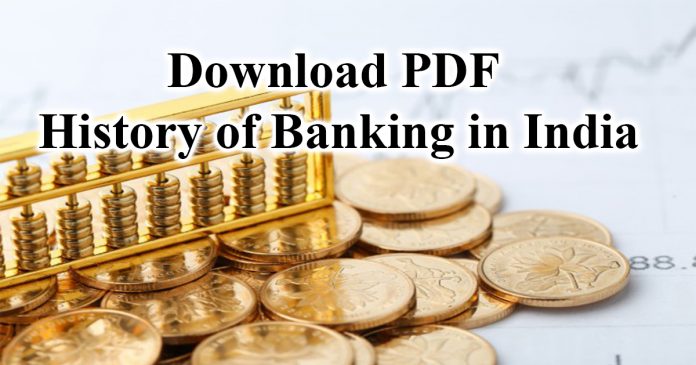History of Banking in India PDF gives the brief history of banking sector in India. It gives you the history of banking before independence, E-banking, history of Reserve bank, history of SBI bank and many more. This pdf is very important for Banking exams like IBPS PO and Clerk, SBI, RBI and others.
Download Banking Study Material
Download Budget, Economic Survey 2018 and other Facts and Figures in 2018 PDF
Download History of Banking in India pdf
Get 200 IBPS Mocks for Rs. 299
Many questions are being asked in SBI Clerk previous papers from banking history. Take a free mock test for SBI Clerk to practice more.
History of Banking in india:
You can go through the details below or you can download History of Banking in India PDF. and can learn later.
Earliest Bank of India:
Bank of Hindostan (or) Bank of Hindustan (1770-1832) considered as among the first modern banks in colonial India. It was dissolved in 1832.
Origin of State Bank of India:
- The largest bank, and the oldest still in existence, is the State Bank of India (S.B.I). It originated as the Bank of Calcutta in June 1806.
- In 1809, it was renamed as the Bank of Bengal. This was one of the three banks funded by a presidency government (British Govt), the other two were the Bank of Bombay in 1840 and the Bank of Madras in 1843.
- The three banks were merged in 1921 to form the “Imperial Bank of India”, It acted as Central Bank of India (or) Quasi-central bank till the establishment of RBI in 1935.
- After India’s independence, Imperial Bank of India became the State Bank of India in 1955.
- In 1960, the State Banks of India was given control of eight state-associated banks under the State Bank of India (Subsidiary Banks) Act, 1959. These are now called its associate banks.
As you have learned history of SBI bank you can also practice free online GK tests for IBPS PO and other banking exams to practice questions from History of Banking in India PDF topic.
Joint Stock Bank:
A bank which is a public company with shares owned by investors rather than a government. Allahabad Bank (est. 1865) is the oldest Joint Stock Bank in India.
Punjab National Bank:
- Lala Lajpat Rai founded Punjab National Bank on 19th May 1894, Lahore, Pakistan.
- The founding board was drawn from different parts of India professing different faiths and of varying back-ground with, the common objective of creating a truly national bank that would further the economic interest of the country.
- PNB has the distinction of being the first Indian bank to have been started solely with Indian capital that has survived to the present. (The first entirely Indian bank, Oudh Commercial Bank, was established in 1881 in Faizabad, but failed in 1958.)
- PNB has had the privilege of maintaining accounts of national leaders such as Mahatma Gandhi, Jawahar Lal Nehru, Lal Bahadur Shastri, Indira Gandhi, as well as the account of the famous Jalianwala Bagh Committee
Central Bank of India:
The Central Bank of India was established on 21 December 1911 by Sir Sorabji Pochkhanawala with Sir Pherozeshah Mehta as Chairman, and claims to have been the first commercial Indian bank completely owned and managed by Indians.
Bank of India:
- Bank of India is commercial bank with headquarters at Bandra Kurla complex, Mumbai. Founded in 1906, it has been government-owned since nationalisation in 1969.
- Bank of India is the first Bank in India to open a branch in overseas. In 1946 the bank opened a branch in London and then in 1974 opened a branch in Paris. This was the first branch of an Indian bank in Europe.
Bank of Baroda:
- Bank of Baroda (BoB) is an Indian state-owned International banking and financial services company headquartered in Vadodara (earlier known as Baroda) in Gujarat, India.
- The bank was founded by the Maharaja of Baroda, Maharaja Sayajirao Gaekwad III on 20 July 1908 in the Princely State of Baroda, in Gujarat.
- It has more number of branches in abroad among Indian Banks.
Union Bank of India:
Union Bank of India (Union Bank) was registered on 11 November 1919 as a limited company in Mumbai and was inaugurated by Mahatma Gandhi. It is the first bank in India which introduced ATM’s.
This is the history of Union Bank of India which is also covered in this pdf.
Reserve Bank of India:
History of Reserve Bank of India:
- The Reserve Bank of India (RBI) is India’s central banking institution, which controls the monetary policy of the Indian rupee.
- It commenced its operations on 1 April 1935 during the British Rule in accordance with the provisions of the Reserve Bank of India Act, 1934.
- The original share capital was divided into shares of 100 each fully paid, which were initially owned entirely by private shareholders. Following India’s independence on 15 August 1947, the RBI was nationalised on 1 January 1949.
Hilton-Young Commission:
- The Reserve Bank of India was set up on the basis of the recommendations of the Royal Commission on Indian Currency and Finance also known as the Hilton-Young Commission.
- The Preamble of the RBI describes its basic functions to regulate the issue of bank notes, keep reserves to secure monetary stability in India, and generally to operate the currency and credit system in the best interests of the country.
- The Central Office of the RBI was established in Calcutta (now Kolkata) but was moved to Bombay (now Mumbai) in 1937.
Banking Regulation Act, 1949:
- The Banking Regulation Act, 1949 is a legislation in India that regulates all banking firms in India. This is an important point to remember form this History of Banking in India pdf.
- Initially, the law was applicable only to banking companies. But, 1965 it was amended to make it applicable to cooperative banks and to introduce other changes.
Banking Reforms in India:
- Banking Reforms in India is a continuous ongoing process. The first such reform was Nationalization of Imperial Bank of India to State Bank of India in 1955 and then Nationalization of Seven State Banks of India (formed subsidiary) took place on 19th July, 1960.
- In 1969, the Indira Gandhi-headed government nationalized 14 major commercial banks(Allahabad Bank, Bank of Baroda, Bank of India, Bank of Maharashtra, Canara Bank, Central Bank of India, Dena Bank, Indian Bank, Indian Overseas Bank, Punjab & Sind Bank, Punjab National Bank, Syndicate Bank, UCO Bank,United Bank of India)
- In 1980, a further 6 banks were nationalized (Andhra Bank, Corporation Bank, New Bank of India, Oriental Bank of Commerce, Punjab & Sindh Bank, Vijaya Bank).
Regional Rural Banks:
Regional Rural Banks were formed on Oct 2, 1975. The objective behind the formation of RRBs was to serve large unserved population of rural areas and promoting financial inclusion.
National Bank for Agriculture and Rural Development:
- NABARD was established on the recommendations of B.Sivaraman Committee, on 12 July 1982 to implement the National Bank for Agriculture and Rural Development Act 1981.
- It replaced the Agricultural Credit Department (ACD) and Rural Planning and Credit Cell (RPCC) of Reserve Bank of India, and Agricultural Refinance and Development Corporation (ARDC).
- It is one of the premier agencies providing developmental credit in rural areas. NABARD is India’s specialised bank for Agriculture and Rural Development in India.
EXIT Bank:
Export–Import Bank of India is the premier export finance institution in India, established in 1982 under Export-Import Bank of India Act 1981. Since its inception, Exim Bank of India has been both a catalyst and a key player in the promotion of cross border trade and investment.
National Housing Bank:
- National Housing Bank (NHB), a wholly owned subsidiary of Reserve Bank of India (RBI), was set up on 9 July 1988 under the National Housing Bank Act, 1987.
- NHB is an apex financial institution for housing. NHB has been established with an objective to operate as a principal agency to promote housing finance institutions both at local and regional levels and to provide financial and other support incidental to such institutions and for matters connected therewith.
SIDBI Bank:
Small Industries Development Bank of India, is an independent financial institution aimed to aid the growth and development of micro, small and medium-scale enterprises (MSME) in India. Set up on April 2, 1990 through an act of parliament, it was incorporated initially as a wholly owned subsidiary of Industrial Development Bank of India.
Other Important Points to remember from History of Banking in India PDF
Financial sector is the backbone of any economy and it plays a crucial role in the mobilization and allocation of resources. The main objectives of the financial sector reforms are to allocate the resources efficiently, increasing the return on investment and accelerated growth of the real sectors in the economy. So various committees are appointed to assess and bring reforms in the financial sector.
Banking Committees of India as on 2017:
Chakravarty Committee (1985): To assess the functioning of the Indian Monetary system
Vaghul Committee (1987): Money Market in India
Rangarajan Committee (1988): Computerization in Indian Banks
Narasimham Committee(1991): To analyze India’s banking sector and recommending legislation and regulations to make it more effective, competitive and efficient.
Download SBI Clerk detailed syllabus PDF
The national economy contracted in July 1991 as the Indian rupee was devalued. The currency lost 18% relative to the US dollar, and the Narsimham Committee advised restructuring the financial sector by a temporal reduced reserve ratio as well as the statutory liquidity ratio.
New guidelines were published in 1993 to establish a private banking sector. Subsequently RBI gave permissions to ICICI, HDFC, Axis Bank, IDBI, Indus, DCB. This turning point was meant to reinforce the market and was often called neo-liberal. This first phase was a success and the central government forced a diversity liberalization to diversify owner structures in 1998.
The National Stock Exchange of India took the trade on in June 1994 and the RBI allowed nationalized banks in July to interact with the capital market to reinforce their capital base. The central bank founded a subsidiary company—the Bharatiya Reserve Bank Note Mudran Private Limited—on 3 February 1995 to produce banknotes.
The Narsimhan committee in 1998 recommended entry of more private players and RBI gave license to Kotak Mahindra Bank (2003), Yes Bank (2004).
The Foreign Exchange Regulation Act (FERA) was legislation passed in India in 1973 that imposed strict regulations on certain kinds of payments, the dealings in foreign exchange (forex) and securities and the transactions which had an indirect impact on the foreign exchange and the import and export of currency
The Foreign Exchange Management Act, 1999 (FEMA) is an Act of the Parliament of India “to consolidate and amend the law relating to foreign exchange with the objective of facilitating external trade and payments and for promoting the orderly development and maintenance of foreign exchange market in India”.
Bharatiya Mahila Bank (BMB) was an Indian financial services banking company based in Mumbai, India. Former Indian Prime Minister Manmohan Singh inaugurated the system on 19 November 2013 on the occasion of the 96th birth anniversary of former Indian Prime Minister Indira Gandhi. The bank was merged with State Bank of India on 31 March 2017.
Payments banks is a new model of banks conceptualised by the Reserve Bank of India (RBI). These banks can accept a restricted deposit, which is currently limited to ₹1 lakh per customer and may be increased further. These banks cannot issue loans and credit cards. Both current account and savings accounts can be operated by such banks. Payments banks can issue services like ATM cards, debit cards, net-banking and mobile-banking. Airtel has launched India’s first live payments bankfollowed by Paytm & India Post Payments Bank.
Download Current affairs 2018 PDF
Download RBI Grade B Study Material
The India Post Payments Bank has been recently incorporated as a Public Limited Company under the Department of Posts with 100% GOI equity.
RBI listed SBI, HDFC, ICICI banks as “Too big to fail”.
Industrial Credit and Investment Corporation of India(ICICI) is the first bank in India to start Internet Banking.
Axis Bank has more number of ATM machines in India after SBI.
This is the brief history of History of Banking in India which is also given in PDF format.
SBI Merger & Consequences:
State Bank of India, which is India’s largest Bank merged with five of its Associate Banks (State Bank of Bikaner & Jaipur, State Bank of Hyderabad, State Bank of Mysore, State Bank of Patiala and State Bank of Travancore) and Bharatiya Mahila Bank with itself. This is the first ever large scale consolidation in the Indian Banking Industry. With the merger, State Bank of India will enter the league of top 50 global banks with a balance sheet size of ₹33 trillion, 278,000 employees, 420 million customers, and more than 24,000 branches and 59,000 ATMs.
As you have downloaded History of Banking in India PDF as on 2017, you can also download and learn Banks and their Headquarters-Charimans and Taglines PDF.
Download All GK PDF’s from General Knowledge questions and answers for Competitive exams PDF.





